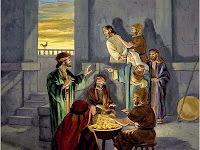'Twas
an everyday affair –
Long
ago as Christ and Peter –
"Warmed
them" at the "Temple fire."
"Thou
wert with him" – quoth "the Damsel"?
"No"
– said Peter, 'twasn't me –
Jesus
merely "looked" at Peter –
Could
I do aught else – to Thee?
F232
(1861) 203
Dickinson
compares something that clearly felt like betrayal to her to Christ’s betrayal
by Peter the night Christ was arrested. Earlier, Jesus had prophesied that
Peter would “thrice deny that thou knowest me” before morning, and Peter had
earnestly sworn he would never do so. After the arrest, he followed “afar off,”
finally catching up with the arrest party at the house of the High Priest where
Jesus had been taken. There he sat by a fire within sight of Jesus. Sure
enough, three people each identified him as a disciple, and three times Peter
denied it categorically: “I know him not” (Luke 22). The third time this
happened, Jesus turned and looked at him. He said nothing and no gestures are
mentioned. Exactly what the look was – sorrow, anger, hurt – we don’t know. It
seems likely, though, that it was sorrow and, Dickinson implies, forgiveness –
or at least acceptance.
 |
| The Look |
Dickinson
relocates the scene to the Temple, perhaps for brevity’s sake. She also omits
the end of the story where Peter “wept bitterly.” The story, though, would have
been thoroughly familiar to readers of her day and still is to churchgoers and
even to anyone who ever watched a play (or the movie) about that night.
Although
this is a powerful story of cowardly denial of a beloved master, the poet
brings it up ever so casually. “’Twas an everyday affair,” she writes. “Long
ago….” You can imagine a friend or former lover approaching and asking if he could
ever be forgiven. No problem, you say, after all, Jesus didn’t castigate Peter;
he simply “looked” at him. And if Jesus were so accepting of that failure of
courage and devotion, how could I chastise you? It’s a bit of a guilt trip: she
may be withholding a bit of graciousness by comparing the forgetful guy to
Peter. But then, we don’t know what was forgotten so long ago. I suspect it was
something very important at the time.
The
first stanza refers to the forgetful person as “He” while in the second she
addresses him directly as “Thee” – a form of “you” that implies friendship, at
least. The shift denotes the forgiveness. What is left unsaid is whether or not
the forgiven one, like Peter, shows complete remorse.
Johnson (1955) dated F232 “about 1860”. Franklin’s (1998) date, usually more reliable, is “late spring 1861”. In either case, Bowles sent Austin his “betrayal” note in January 1862, so the “He” probably isn’t Bowles (Comment 2, 4 Feb 2023, F196. TPB).
ReplyDeleteIf the “He” is a disguised gender switch of “She”, then the person guilty of imagined betrayal could be Sue. A search of most of ED’s early letters to Sue from 1850-1861 uncovered no mention of a promise of “eternal love”(*), but that doesn’t rule out a verbal promise during the early 1850s.
With the caveat that I may be proposing what I want to believe, my money is on Sue as the subject of this poem, and ED’s implied “betrayal” stems from her feelings of abandonment by Sue. The reality of Sue’s marriage responsibilities probably exceeded anything ED imagined when she played matchmaker in the early 1850s.
Fortunately for ED buffs, she had the wisdom and fortitude to keep her mouth shut about it, except in disguised poetic references that only she and Sue would understand. Unfortunately for ED, her self-imposed silence about their early lesbian days, which prevented internal volcanic pressures from a destructive eruption, created unimaginable internal pain. “Could I do aught else – to Thee?”.
(*) Open Me Carefully: Emily Dickinson's Intimate Letters to Susan Huntington Dickinson (Hart and Smith, 1998, Sections 1 and 2). Wesleyan University Press. Kindle Edition.